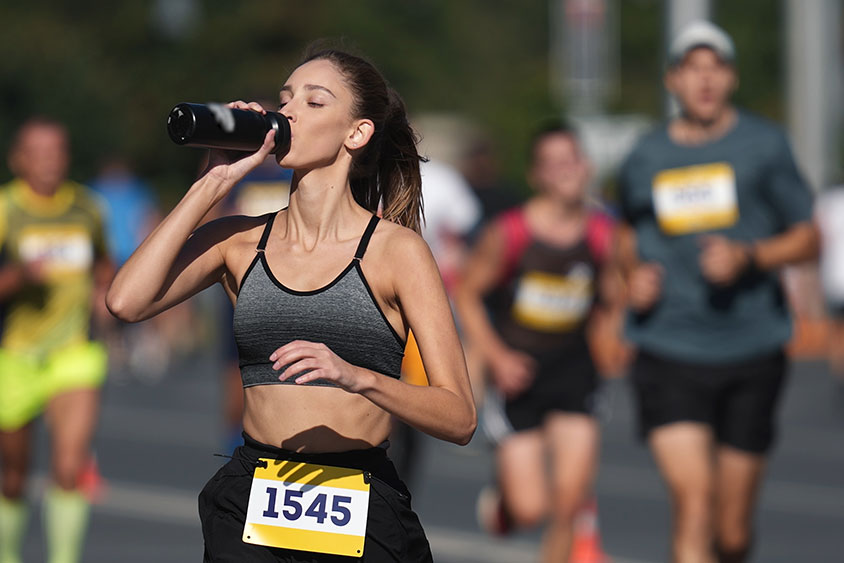
The effects of proper fueling on running performance can’t be understated; an expert panel from the National Library of Medicine (NIL) states that many athletes still do not consume enough carbohydrates during exercise. This deficit can negatively affect performance, even if you’re not an elite. However, knowing that fuel is necessary and implementing it can be very different. With so many options on the market, it’s tough to know where to start. Part of the process is trial and error, but being informed is a good first step. Use this guide to jumpstart your efforts to choose the right running fuel for your needs.
Why Trust Us?
ACTIVE.com's editorial team relies on the knowledge and experience of fitness and wellness experts, including competitive athletes, coaches, physical therapists, nutritionists, and certified trainers. This helps us ensure that the products we feature are of the highest standard. Collectively, the team has spent countless hours researching equipment, gear, and recovery tools to create the most accurate, authentic content for our readers. Customer satisfaction is also a key part of our review process, which is why we only feature highly rated products.
Fueling How-To
Wondering where to begin? Generally, runs that last less than an hour don’t need fuel, but once you start running for 75 minutes or more, some carbohydrates can boost performance and endurance. Rachel Gargano, MS, RD, CSSD, CBS, and the Chief Registered Dietitian for Live it Up, says that the key is to add in fuel gradually.
Start slow by eating once every 60 to 75 minutes. Aim for about 20 to 25 grams of carbohydrates at each eating session. And make sure your fuels are low-fat, low-fiber, and low-protein (easy-to-digest carbs make the best fuels!) to help prevent digestive issues.
She advises increasing the frequency once you’ve trained your stomach to accept fuel. Individual needs may vary, but in general, Gargano recommends the following fueling guidelines for runners:
- 1 to 2-hour run: 30-60 grams of carbs per hour
- 2+ hour run: 60-90 grams of carbs per hour
If you’re newer to or have never fueled, these numbers might seem overwhelming, but remember, it doesn’t have to be all at once. If you sip on a carbohydrate drink on the run and consume a gel every 30 minutes, you’ll be well on your way to meeting the targets.
How To Choose
Once you know when and how much to take, the next step is figuring out what you like (and can tolerate!). The texture and consistency of fuel vary greatly. You might gravitate toward a carbohydrate drink if you struggle to chew and run. If you like something with a bit of chew, items like Clif Shot Bloks can get the job done. If you don’t mind the gel's consistency, this fuel type tends to be the easiest to carry and access on the run. Fluid bottles might be convenient for loops around the neighborhood, but think ahead to any upcoming goal races. Will you be able to carry your fuel, or will you rely on the race’s nutrition and hydration options? Head to their website to preview what a race will offer on-course. The information about what will be provided and where is often prominently posted. But remember that most marathons only offer two gel stations – you’ll need to carry more to stay well-fueled.
Gels & Chews
Gels and chews are the most common fuel options. In general, a single gel contains about 25 grams of carbohydrates. Certain brands, such as SiS Beta gel, pack in more, but the packaging may be larger. Be sure to look at how much (if any) sodium is included in the gel or chews, as electrolytes are crucial for longer and/or warmer races.
Many sports nutrition brands offer a caffeinated version of their gels and chews. While caffeine can positively affect running endurance, knowing precisely what you’re getting is essential. While both Skratch green tea chews and Maurten gels are advertised as caffeinated, the Skratch chews contain two grams of caffeine per serving, while the Maurten gel includes 100 milligrams (or the equivalent of a cup of coffee). If you’re consuming multiple gels over the course of a run or race, keep track of the caffeine, as too much might cause heart palpitations or stomach distress. There are also many middle-of-the-road options, such as caffeinated Gu gels, which have 20 grams, and caffeinated Neversecond gels, which contain about 75 grams.
Pros: Easy to carry, offered on most marathon and half-marathon courses
Cons: Consistency can be difficult for some runners to manage, especially during more strenuous efforts
Liquids
Liquids can serve double duty as fuel and hydration, making them a wise choice for hot or humid runs. And since there’s no chewing involved, liquid drinks are easy to consume, even during strenuous efforts. Many high-carb hydration mixes are on the market, so look for something like Maurten 160 or Skratch Lab’s high-carb drink. You’ll want to ensure your liquid contains enough carbs for your effort – electrolyte drinks like Nuun won’t cut it. And if you plan to consume liquids as fuel, it’s wise to invest in a comfortable hydration vest, like this option from Camelbak, or a hand-held water bottle. I’ve personally used both of these products for summer marathon training cycles!
Pros: Digests easily, easy to consume (i.e., no chewing!)
Cons: It can be difficult to carry enough liquid to fuel an entire long run or race – you’ll need a plan for refilling; consuming too much liquid can cause a sloshy stomach
Real Food
If you’re intrigued by whole foods or don’t love the taste and texture of gels, there are a few things to keep in mind. Gargano says, “Whole foods such as dried fruit usually take quite a while to digest. First, they take more chewing power, which may cause an athlete to swallow more air and result in burping and gas. Second, the more fat, fiber, and protein a food contains, the longer it sits in the stomach during the second phase of digestion. Gargano adds that some dried fruits also contain high amounts of sorbitol, which can pull fluids into the intestines and cause a laxative effect. If you want to try whole foods and avoid stomach issues, Gargano suggests starting with dried bananas, dates, or pretzels. You might also consider a food-based gel such as Huma, which is made with chia seeds.
Pros: It may have a more appealing taste and texture, is easy to find at a regular grocery store, and is cheaper than gels
Cons: Can cause stomach distress, may be difficult to carry
Whatever you choose to fuel with, remember that practicing with the product is key. If you’re beginning a training cycle, it can be wise to stock up on a few different options and test them out to see what you like the most. Be sure to test out fuel during various types of efforts—your stomach may react differently to a gel at a race pace than it does at an easy pace. Happy running!



